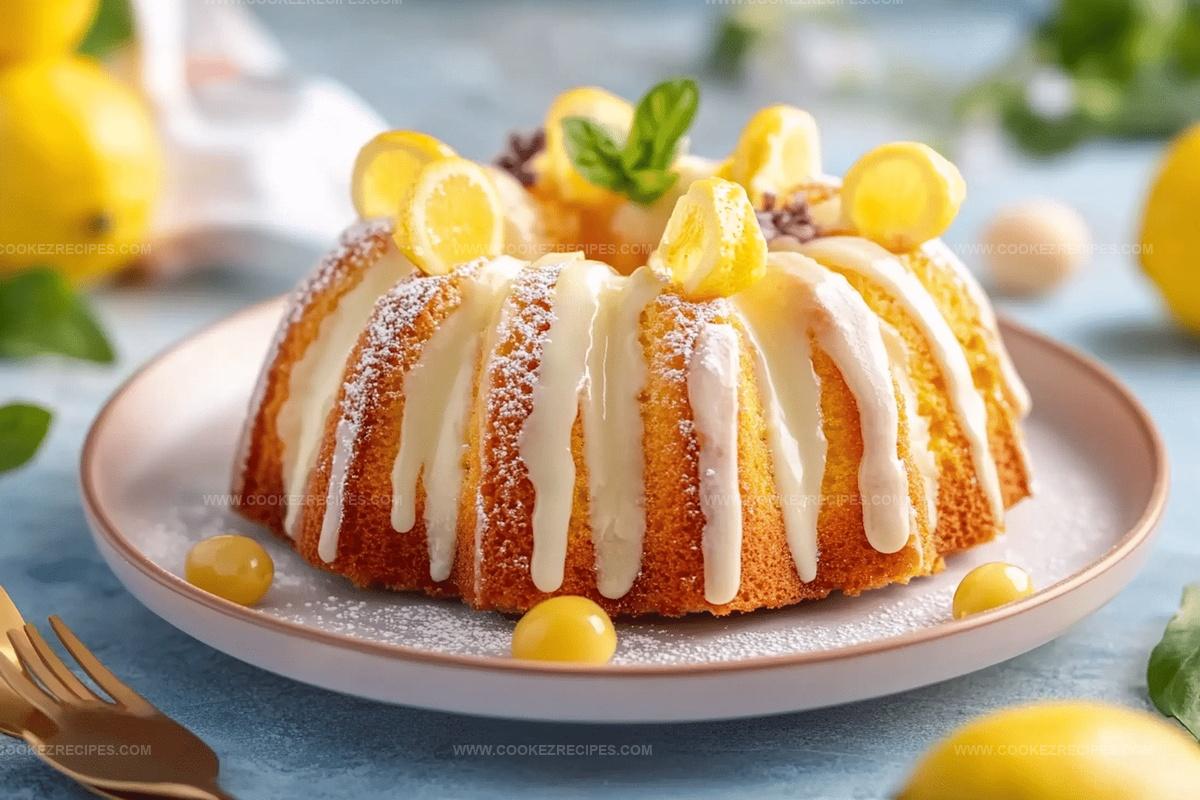Easter Lemon Bundt Cake Recipe with Bright Citrus Glaze
Spring’s vibrant energy bursts through this delectable easter lemon bundt cake that promises pure sunshine on a plate.
Zesty citrus notes dance across a tender crumb, creating a dessert that sparkles with brightness.
Memories of childhood celebrations whisper through each delicate slice, inviting nostalgia and joy.
Soft, moist layers meld perfectly with tangy lemon glaze, offering a refreshing twist on traditional holiday treats.
Bakers of all skill levels can confidently craft this stunning centerpiece that impresses without overwhelming.
Delightful aromas will fill your kitchen, signaling a special moment of culinary magic waiting to unfold.
Easter Lemon Bundt Cake That’s Zesty And Bright
Bundt Cake Flavor for Easter Lemon Version
Cake Base Ingredients:Wet Ingredients:Leavening and Seasoning:Cake Release and Coating:Glaze Ingredients:Decoration:Easter Lemon Bundt Cake – Instructions for Preparation
Step 1: Prepare Baking Station
Get your oven warmed up to 350°F.
Generously coat a 10-inch bundt pan with nonstick spray or create a homemade cake release by mixing:Brush the mixture thoroughly inside the pan.
Step 2: Create Dry Ingredient Blend
Grab a medium bowl and whisk together:Blend for about a minute until everything looks evenly combined.
Step 3: Mix Wet Ingredients
In a large mixing bowl, beat oil and sugar at high speed for one minute, then reduce to medium speed.
Add eggs one at a time, mixing after each addition.
Stir in:Step 4: Combine Wet and Dry Mixtures
Switch mixer to low speed.
Gradually add dry ingredients and yogurt, alternating and starting/ending with flour mixture.
Mix until just combined.
Step 5: Fill Bundt Pan
Pour batter into prepared pan.
Tap gently on the counter to release any air bubbles.
Step 6: Bake to Perfection
Slide pan into oven and bake for 25-30 minutes.
Check doneness by inserting a toothpick – it should come out clean with a golden brown cake.
Step 7: Cool Down
Let cake rest in pan for 15 minutes, then transfer to a wire rack to cool completely.
Step 8: Create Lemon Glaze
Whisk together in a small bowl:Ensure the mixture is smooth and lump-free.
Step 9: Finish and Decorate
Drizzle glaze over cooled cake.
Add mini chocolate eggs, extra lemon zest, and optional edible flowers for a festive touch.
Bundt Cake Tips With Easter Lemon Twist
Enjoy Easter Lemon Bundt Cake a Second Time
Elegant Picks For Lemon Bundt Cake
Easter Lemon Bundt Cake Styles
FAQs
This cake captures spring flavors with bright lemon notes and can be decorated with pastel-colored mini chocolate eggs and edible flowers, making it a festive Easter dessert.
Yes, you can replace yogurt with sour cream, use bottled lemon juice if fresh isn’t available, and swap vegetable oil with canola oil without significantly changing the cake’s texture.
Thoroughly grease the bundt pan using nonstick spray or homemade cake release (mixture of shortening, oil, and flour) and let the cake cool in the pan for 15 minutes before removing to prevent breaking.
Mix ingredients just until combined, avoid overmixing the batter, and alternate adding dry ingredients and yogurt to create a tender, moist cake with consistent texture.
Print
Easter Lemon Bundt Cake Recipe
- Total Time: 1 hour
- Yield: 12 1x
Description
Springtime celebrations come alive with this elegant Easter Lemon Bundt Cake, promising zesty delight and sunny memories. Creamy glaze and delicate crumb invite you to savor each refreshing slice of pure seasonal joy.
Ingredients
Cake Dry Ingredients:
- 2 cups (480 milliliters) all-purpose flour
- 1 teaspoon baking soda
- 1 teaspoon baking powder
- 1/2 teaspoon salt
Cake Wet Ingredients:
- 3 large eggs, room temperature
- 1 cup (200 grams) granulated sugar
- 3/4 cup (180 milliliters) vegetable oil
- 1/2 cup (120 milliliters) full-fat yogurt, room temperature
- 1/4 cup (60 milliliters) lemon juice, freshly squeezed
- 1 teaspoon vanilla paste or pure vanilla extract
- Zest of 2 large lemons
Glaze and Decoration:
- 1 1/2 cups (180 grams) powdered sugar
- 2 tablespoons (30 milliliters) milk
- 1 tablespoon (15 milliliters) lemon juice, freshly squeezed
- 3/4 cup mini chocolate eggs
- Additional lemon zest for garnish
Instructions
- Meticulously coat a 10-inch bundt pan with nonstick spray, ensuring complete coverage to prevent cake sticking.
- Combine flour, baking soda, baking powder, and salt in a medium bowl, whisking thoroughly to distribute ingredients evenly.
- Vigorously blend oil and sugar in a large mixing bowl until the mixture becomes light and fluffy.
- Incorporate eggs individually, mixing completely after each addition to create a smooth, uniform batter.
- Infuse the mixture with vanilla extract, freshly squeezed lemon juice, and fragrant lemon zest, stirring until well integrated.
- Gradually fold dry ingredients and yogurt into the wet mixture, alternating between the two and mixing gently to maintain batter’s delicate texture.
- Transfer batter into the prepared bundt pan, gently tapping to eliminate any trapped air bubbles.
- Bake in a preheated 350°F oven for 25-30 minutes, monitoring until a toothpick emerges clean and the cake develops a golden-brown hue.
- Allow cake to rest in the pan for 15 minutes, then carefully release onto a wire rack for complete cooling.
- Prepare glaze by whisking powdered sugar, milk, and lemon juice until achieving a silky, smooth consistency.
- Drizzle glaze artfully over the cooled cake, allowing it to cascade down the bundt’s distinctive ridges.
- Embellish with mini chocolate eggs, additional lemon zest, and delicate edible flowers for a festive easter presentation.
Notes
- Use fresh, high-quality lemons for the most vibrant citrus flavor and zesty aroma that will make your cake pop.
- Ensure all ingredients are at room temperature to help them blend seamlessly and create a smoother, more consistent batter.
- Avoid overmixing the batter after adding flour to prevent a tough, dense cake texture that can ruin the delicate crumb.
- Customize the glaze by adjusting lemon juice for more tang or adding a touch of food coloring for a festive Easter look.
- Prep Time: 30 minutes
- Cook Time: 30 minutes
- Category: Desserts
- Method: Baking
- Cuisine: American
Nutrition
- Serving Size: 12
- Calories: 340
- Sugar: 25 g
- Sodium: 150 mg
- Fat: 16 g
- Saturated Fat: 2 g
- Unsaturated Fat: 14 g
- Trans Fat: 0 g
- Carbohydrates: 44 g
- Fiber: 1 g
- Protein: 4 g
- Cholesterol: 35 mg




Daniel Bruns
Founder & Culinary Innovator
Expertise
Recipe development for home cooks, Nutritional analysis and meal planning, Culinary education and food writing
Education
Auguste Escoffier School of Culinary Arts
Diploma in Culinary Arts and Operations
Focus: Classical and contemporary cooking techniques, Culinary entrepreneurship and kitchen management, Menu development and food cost analysis
Daniel’s story started with flour on his face and a pie in the oven at his grandma’s house. He later sharpened his skills at the Auguste Escoffier School of Culinary Arts.
His goal? Recipes so simple you’ll want to cook every night. When he’s not whipping up one-pan wonders, Daniel’s outside picking herbs, hosting neighborhood cook-offs, or baking chocolate cakes with his kids, messy, sweet, and unforgettable.